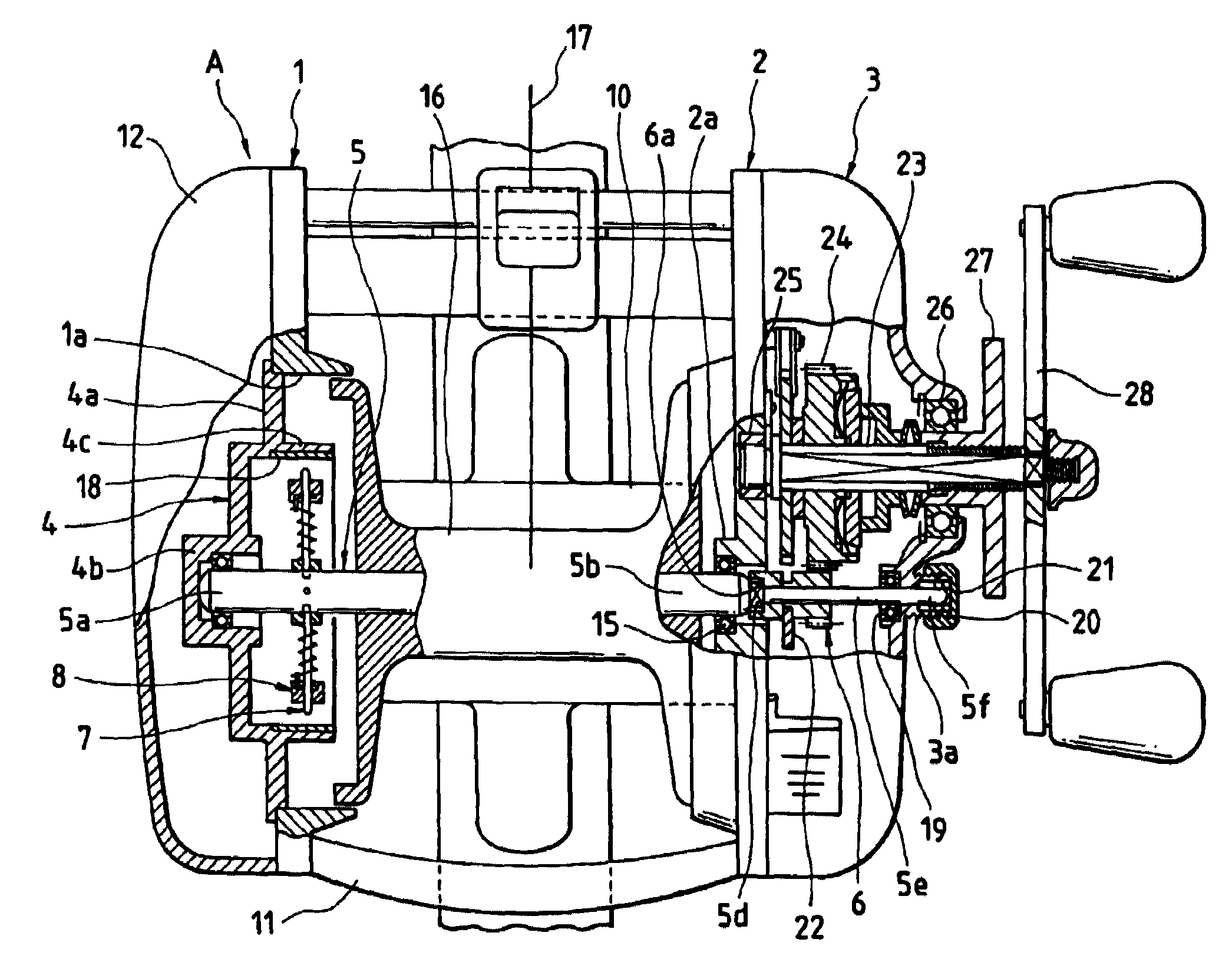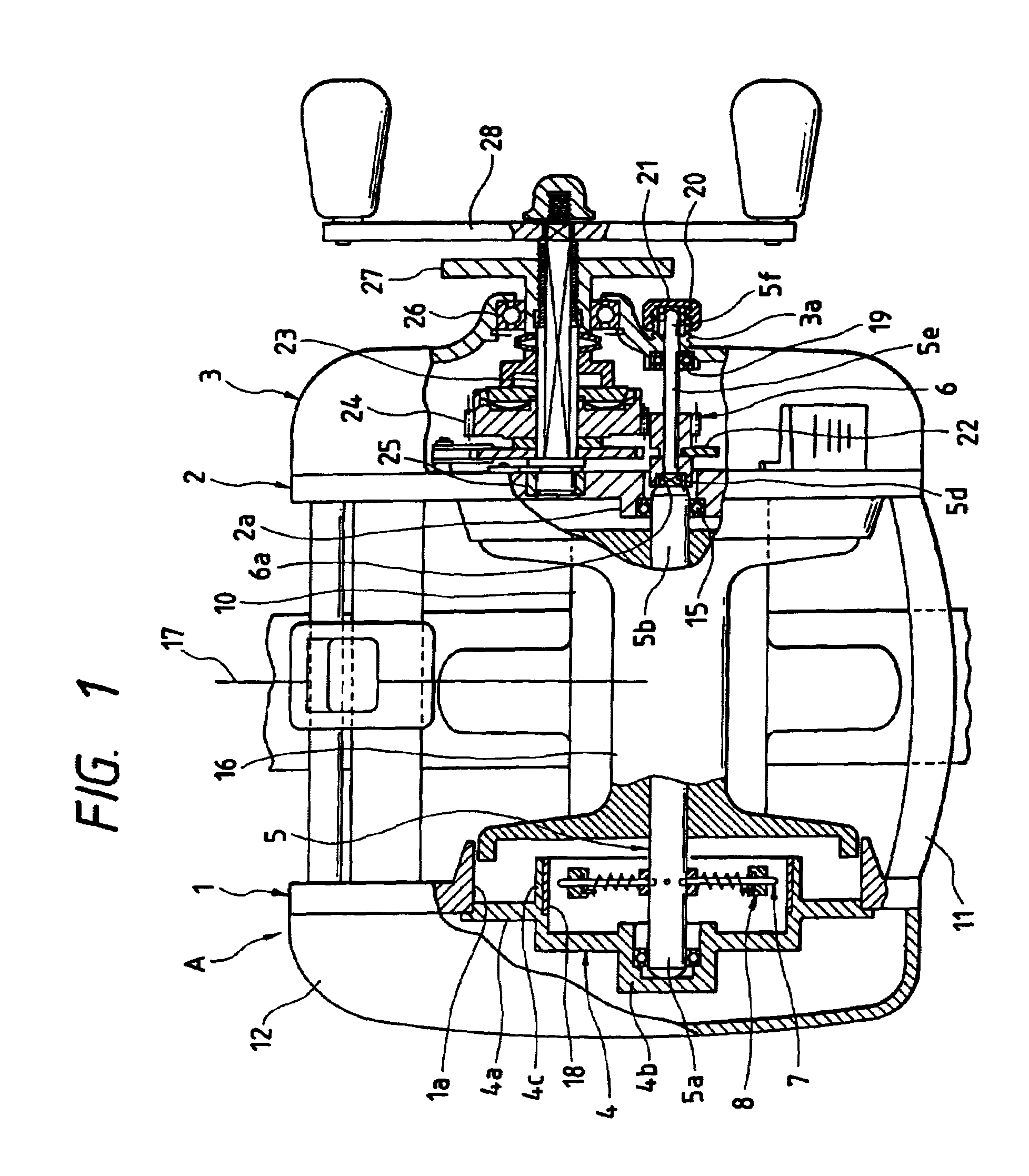Fishing reel
a reel and reel body technology, applied in the field of fishing reels, can solve the problems of inability to rotate the spool smoothly and lightly (freely), inability to cope with sufficient and positive brake force applied to the spool, and inability to carry out such casting operations as to be able to cope sufficiently and positively, so as to prevent the occurrence of backlash in the spool and extend the carrying distance of the terminal tackles
- Summary
- Abstract
- Description
- Claims
- Application Information
AI Technical Summary
Benefits of technology
Problems solved by technology
Method used
Image
Examples
first embodiment
[0039]Now, description will be given below of a second embodiment of a fishing reel according to the invention with reference to the accompanying drawings. By the way, in the present embodiment, description will be given of a double-bearing type reel as a fishing reel. FIGS. 1 to 3 respectively show a first embodiment of the invention: in particular, FIG. 1 is a sectional plan view of the main portions of a fishing reel of a double-bearing type; FIG. 2 is an enlarged sectional plan view of the main portions of the left side of a fishing reel of a double-bearing type; and, FIG. 3 is an enlarged sectional plan view of the main portions of the left side of a fishing reel of a double-bearing type.
[0040]In FIG. 1, in a fishing reel of a double-bearing type, left and right side frames 1 and 2, which cooperate together in forming a reel main body A, are held in parallel to each other by a support column (not shown), a reel leg fixing plate 10 and a finger placement plate 11, while reel sid...
second embodiment
[0084]Now, description will be given below of a second embodiment of a fishing reel according to the invention with reference to the accompanying drawings. By the way, in the present embodiment, description will be given of a double-bearing type reel as a fishing reel.
[0085]As shown in FIG. 7, a double-bearing type reel 101 comprises a frame 102 including left and right frames 102a and 102b and a rod mounting portion (not shown) formed integrally with the central portions of the left and right frames 102a and 102b, and a reel main body 104 including left and right side plates 103a and 103b which are respectively mounted on the left and right frames 102a and 102b.
[0086]Between the left and right frames 102a and 102b (left and right side plates 103a and 103b), there is rotatably supported a spool shaft 106 through bearings 107a and 107b; and, on the spool shaft 106, there is mounted a spool 106a around which a fishing line can be wound.
[0087]The spool 106a is structured such that it ...
third embodiment
[0132]Now, description will be given below of a third embodiment of a fishing reel according to the invention. By the way, in the present embodiment, description will be also given of a double-bearing type reel as a fishing reel. In this third embodiment, the portions similar in structure to the second embodiment are given the same designation and thus the description thereof are omitted here.
[0133]As shown in FIGS. 12 to 13B, the centrifugal brake device 290 comprises a support member 292 fixed to the spool shaft 106 in a rotation preventive manner; an annular brake body 294 which is fixed to the reel main body 104 and also in the inner periphery of which there is formed a brake surface 294a; a plurality of brake members 296 which are respectively supported on the support member 292 in a removal preventive manner and can be moved not only in a direction where they approach the brake surface 294a of the annular brake body 294 but also in a direction where they are moved away from th...
PUM
 Login to View More
Login to View More Abstract
Description
Claims
Application Information
 Login to View More
Login to View More - R&D
- Intellectual Property
- Life Sciences
- Materials
- Tech Scout
- Unparalleled Data Quality
- Higher Quality Content
- 60% Fewer Hallucinations
Browse by: Latest US Patents, China's latest patents, Technical Efficacy Thesaurus, Application Domain, Technology Topic, Popular Technical Reports.
© 2025 PatSnap. All rights reserved.Legal|Privacy policy|Modern Slavery Act Transparency Statement|Sitemap|About US| Contact US: help@patsnap.com



